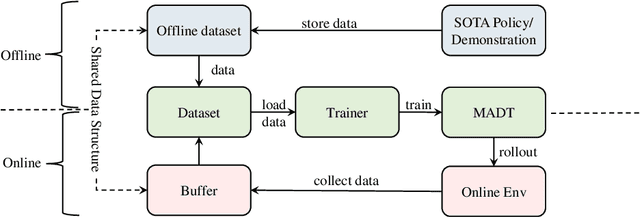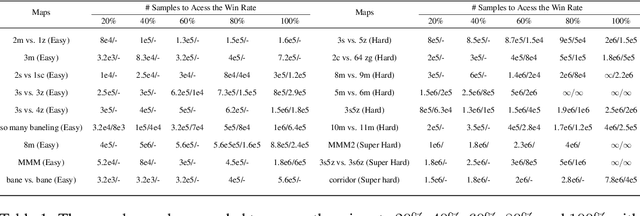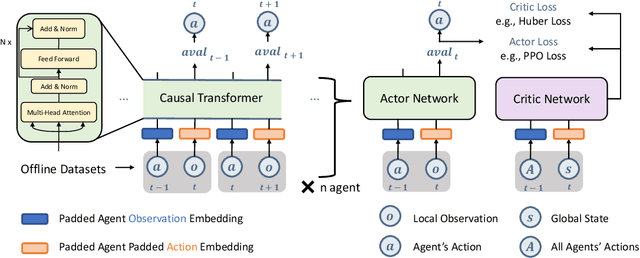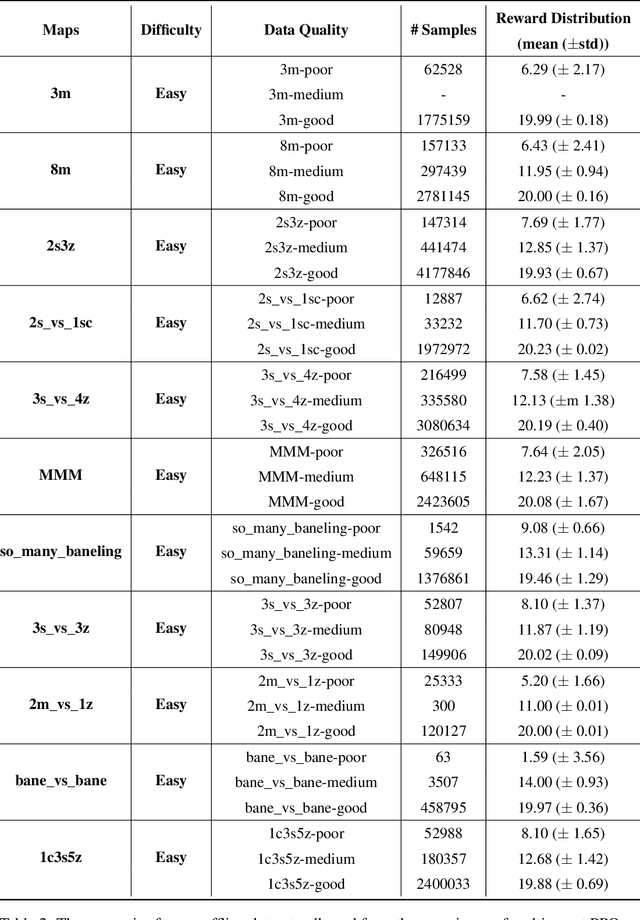Xiyun Li
DPMT: Dual Process Multi-scale Theory of Mind Framework for Real-time Human-AI Collaboration
Jul 18, 2025Abstract:Real-time human-artificial intelligence (AI) collaboration is crucial yet challenging, especially when AI agents must adapt to diverse and unseen human behaviors in dynamic scenarios. Existing large language model (LLM) agents often fail to accurately model the complex human mental characteristics such as domain intentions, especially in the absence of direct communication. To address this limitation, we propose a novel dual process multi-scale theory of mind (DPMT) framework, drawing inspiration from cognitive science dual process theory. Our DPMT framework incorporates a multi-scale theory of mind (ToM) module to facilitate robust human partner modeling through mental characteristic reasoning. Experimental results demonstrate that DPMT significantly enhances human-AI collaboration, and ablation studies further validate the contributions of our multi-scale ToM in the slow system.
Mixture of personality improved Spiking actor network for efficient multi-agent cooperation
May 10, 2023



Abstract:Adaptive human-agent and agent-agent cooperation are becoming more and more critical in the research area of multi-agent reinforcement learning (MARL), where remarked progress has been made with the help of deep neural networks. However, many established algorithms can only perform well during the learning paradigm but exhibit poor generalization during cooperation with other unseen partners. The personality theory in cognitive psychology describes that humans can well handle the above cooperation challenge by predicting others' personalities first and then their complex actions. Inspired by this two-step psychology theory, we propose a biologically plausible mixture of personality (MoP) improved spiking actor network (SAN), whereby a determinantal point process is used to simulate the complex formation and integration of different types of personality in MoP, and dynamic and spiking neurons are incorporated into the SAN for the efficient reinforcement learning. The benchmark Overcooked task, containing a strong requirement for cooperative cooking, is selected to test the proposed MoP-SAN. The experimental results show that the MoP-SAN can achieve both high performances during not only the learning paradigm but also the generalization test (i.e., cooperation with other unseen agents) paradigm where most counterpart deep actor networks failed. Necessary ablation experiments and visualization analyses were conducted to explain why MoP and SAN are effective in multi-agent reinforcement learning scenarios while DNN performs poorly in the generalization test.
Offline Pre-trained Multi-Agent Decision Transformer: One Big Sequence Model Tackles All SMAC Tasks
Dec 20, 2021



Abstract:Offline reinforcement learning leverages previously-collected offline datasets to learn optimal policies with no necessity to access the real environment. Such a paradigm is also desirable for multi-agent reinforcement learning (MARL) tasks, given the increased interactions among agents and with the enviroment. Yet, in MARL, the paradigm of offline pre-training with online fine-tuning has not been studied, nor datasets or benchmarks for offline MARL research are available. In this paper, we facilitate the research by providing large-scale datasets, and use them to examine the usage of the Decision Transformer in the context of MARL. We investigate the generalisation of MARL offline pre-training in the following three aspects: 1) between single agents and multiple agents, 2) from offline pretraining to the online fine-tuning, and 3) to that of multiple downstream tasks with few-shot and zero-shot capabilities. We start by introducing the first offline MARL dataset with diverse quality levels based on the StarCraftII environment, and then propose the novel architecture of multi-agent decision transformer (MADT) for effective offline learning. MADT leverages transformer's modelling ability of sequence modelling and integrates it seamlessly with both offline and online MARL tasks. A crucial benefit of MADT is that it learns generalizable policies that can transfer between different types of agents under different task scenarios. On StarCraft II offline dataset, MADT outperforms the state-of-the-art offline RL baselines. When applied to online tasks, the pre-trained MADT significantly improves sample efficiency, and enjoys strong performance both few-short and zero-shot cases. To our best knowledge, this is the first work that studies and demonstrates the effectiveness of offline pre-trained models in terms of sample efficiency and generalisability enhancements in MARL.
MIMO Self-attentive RNN Beamformer for Multi-speaker Speech Separation
Apr 26, 2021



Abstract:Recently, our proposed recurrent neural network (RNN) based all deep learning minimum variance distortionless response (ADL-MVDR) beamformer method yielded superior performance over the conventional MVDR by replacing the matrix inversion and eigenvalue decomposition with two recurrent neural networks. In this work, we present a self-attentive RNN beamformer to further improve our previous RNN-based beamformer by leveraging on the powerful modeling capability of self-attention. Temporal-spatial self-attention module is proposed to better learn the beamforming weights from the speech and noise spatial covariance matrices. The temporal self-attention module could help RNN to learn global statistics of covariance matrices. The spatial self-attention module is designed to attend on the cross-channel correlation in the covariance matrices. Furthermore, a multi-channel input with multi-speaker directional features and multi-speaker speech separation outputs (MIMO) model is developed to improve the inference efficiency. The evaluations demonstrate that our proposed MIMO self-attentive RNN beamformer improves both the automatic speech recognition (ASR) accuracy and the perceptual estimation of speech quality (PESQ) against prior arts.
 Add to Chrome
Add to Chrome Add to Firefox
Add to Firefox Add to Edge
Add to Edge